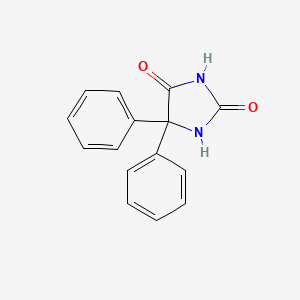Drug Information
Drug (ID: DG00596) and It's Reported Resistant Information
| Name |
Phenytoin
|
||||
|---|---|---|---|---|---|
| Synonyms |
Phenytoin; 5,5-DIPHENYLHYDANTOIN; 57-41-0; Diphenylhydantoin; Dilantin; 5,5-diphenylimidazolidine-2,4-dione; Phenytoine; Zentropil; Epamin; Dihydantoin; Aleviatin; Dilabid; Diphantoin; Diphenylan; Lepitoin; Diphedan; Fenylepsin; Phentytoin; Sodanton; Difenin; Dihycon; Lehydan; Diphenylhydatanoin; Dantoinal; Di-Hydan; Dilantine; Dillantin; Diphenine; Diphentyn; Ditoinate; Elepsindon; Epilantin; Fenitoina; Fenytoine; Hidantilo; Hidantina; Hidantomin; Hydantoinal; Kessodanten; Phanantin; Phanatine; Phenatoine; Sodantoin; Sylantoic; Thilophenyl; Zentronal; Auranile; Dantinal; Dantoine; Difetoin; Difhydan; Dintoin; Dintoina; Diphedal; Diphenin; Enkelfel; Epifenyl; Epihydan; Fentoin; Hidantal; Hydantal; Idantoil; Idantoin; Labopal; Phentoin; Ritmenal; Saceril; Sanepil; Silantin; Solantin; Danten; Denyl; Epelin; Epinat; Epised; Eptal; Hidan; Lepsin; Ekko; Ictalis simple; Toin unicelles; Dilantin acid; Dantoinal klinos; Om-Hydantoine; Di-Phetine; Epdantoine simple; Hidantina vitoria; Gerot-epilan-D; Epilan-D; Neosidantoina; Comitoina; Hidantina senosian; Hydantol; Minetoin; Novantoina; Causoin; Convul; Di-Lan; Ekko capsules; Neos-Hidantoina; 2,4-Imidazolidinedione, 5,5-diphenyl-; Om hidantoina simple; TOIN; Phenhydanin; Phenytex; Phenytoinum; Sinergina; Sodanthon; Iphenylhydantoin; Phenytoin-Gerot; Difenilhidantoina; Fenytoin Dak; Didan TDC 250; Dilantin-125; Epdantoin Simple; Phenytoin AWD; Epilan D; 5,5-Diphenyl-2,4-imidazolidinedione; Diphenat; Hindatal; Hydantin; Epanutin; Fenitoina [INN-Spanish]; Phenytoine [INN-French]; Phenytoinum [INN-Latin]; Difenilhidantoina [Spanish]; Diphenylhydantoine [French]; 5,5-Dwufenylohydantoina; Antisacer; Fenantoin Mn Pharma; Diphenylhydantoine; Di-Lan (VAN); PHENYTOIN SODIUM; Diphenylhydantoin (VAN); Diphentoin; DILANTIN-30; Solantoin; Solantyl; Eptoin; DPH (VAN); PHENYTEK; 5,5-Diphenylimidazolidin-2,4-dione; 5,5-Diphenyl-imidazolidine-2,4-dione; 5,5-Diphenylhydantoin (IUPAC); 5,5-Dwufenylohydantoina [Polish]; Hydantoin, 5,5-diphenyl-; CCRIS 515; CHEBI:8107; NCI-C55765; 5,5-Diphenylhydantoin (phenytoin); UNII-6158TKW0C5; Diphenylan sodium; AI3-52498; 5,5-diphenyl hydantoin; Dilantin (TN); Novophenytoin; MFCD00005264; MLS000069789; Citrulliamon; Phenitoin; 5,5-diphenyltetrahydro-1H-2,4-imidazoledione; Fenidantoin s; NSC8722; 6158TKW0C5; NSC-8722; Epasmir 5; NCGC00021139-03; SMR000059026; DSSTox_CID_541; Fenidantoin 's'; DSSTox_RID_75650; DSSTox_GSID_20541; Epasmir '5'; Didan-tdc-250; CAS-57-41-0; phenytoin (PHN); component of Mebroin; fenidantoin ''s''; epasmir ''5''; NSC 8722; EINECS 200-328-6; SR-01000075211; IFLab1_000214; Fenidantoin 's'; HSDB 3160; Episar (Salt/Mix); Epasmir '5'; Aladdin (Salt/Mix); Alepsin (Salt/Mix); Epsolin (Salt/Mix); Phenytoin (Lepitoin); Tacosal (Salt/Mix); Phenytoin [USAN:USP:INN:BAN:JAN]; Antisacer (Salt/Mix); Epdantoin (Salt/Mix); Epileptin (Salt/Mix); Hydantoin,5-diphenyl-; Spectrum_001105; Fenigramon (Salt/Mix); Citrullamon (Salt/Mix); Opera_ID_394; 2, 5,5-diphenyl-; CHEMBL16; Spectrum2_001281; Spectrum3_000890; Spectrum4_000984; Spectrum5_001369; Lopac-D-4007; Epitope ID:117723; D 4007; SCHEMBL3440; BIDD:PXR0090; Lopac0_000329; Lopac0_000378; Oprea1_373280; BSPBio_001437; KBioGR_001387; KBioSS_001585; MLS001074087; MLS002454401; BIDD:GT0625; DivK1c_000507; Soluble phenytoin (Salt/Mix); SPBio_001281; Phenytoin (JP17/USP/INN); GTPL2624; 2-hydroxy-5,5-diphenyl-3,5-dihydro-4H-imidazol-4-one; DTXSID8020541; KBio1_000507; KBio2_001585; KBio2_004153; KBio2_006721; KBio3_001780; WLN: T5MVMV EHJ ER& ER; 5,5-Diphenylhydantoin, >=99%; NINDS_000507; Phenytoin 1.0 mg/ml in Methanol; SM-88 COMPONENT PHENYTOIN; HMS1412J16; HMS1694O05; HMS1791H19; HMS1989H19; HMS2089E11; HMS2236J06; HMS3261K17; HMS3402H19; HMS3657O03; BCP05960; HY-B0448; Hydantoin, 5,5-diphenyl- (8CI); ZINC2510358; Tox21_110861; Tox21_202299; Tox21_300281; Tox21_500378; AC-376; BDBM50003655; BDBM50101816; s2525; STK058029; STK182871; STL454130; AKOS000416887; AKOS003245432; Tox21_110861_1; 5,5-diphenylimidazolidine-2,4-dione.; CCG-104011; CCG-221682; DB00252; LP00378; MCULE-2376673346; Phenytoin 1000 microg/mL in Methanol; 5,5-di(phenyl)imidazolidine-2,4-dione; IDI1_000507; IDI1_008433; NCGC00015342-01; NCGC00015342-02; NCGC00015342-03; NCGC00015342-04; NCGC00015342-05; NCGC00015342-06; NCGC00015342-07; NCGC00015342-08; NCGC00015342-09; NCGC00015342-10; NCGC00015342-11; NCGC00015342-12; NCGC00021139-01; NCGC00021139-02; NCGC00021139-04; NCGC00021139-05; NCGC00021139-06; NCGC00021139-07; NCGC00021139-08; NCGC00021139-09; NCGC00021139-10; NCGC00021139-11; NCGC00091492-01; NCGC00091492-02; NCGC00091492-03; NCGC00091492-04; NCGC00091492-05; NCGC00093810-01; NCGC00093810-02; NCGC00254135-01; NCGC00259848-01; NCGC00261063-01; 5,5- Diphenyl- 2,4- imidazolidinedione; 5,5-Diphenyl-1H-imidazolidine-2,4-dione; D0894; EU-0100378; FT-0667653; FT-0699999; P-235; SW203757-2; EN300-16818; 5,5-diphenylimidazolidine-2,4-dione;Phenytoin; C07443; D00512; E76094; 2,4-Imidazolidinedione, 5,5-diphenyl- (9CI); 5,5-diphenyl-1H-imidazole-2,4(3H,5H)-dione; AB00374253-10; AB00374253-11; AB00374253_13; A831435; Q410400; SR-01000003141; SR-01000003141-8; SR-01000075211-2; W-105468; BRD-K55930204-001-02-7; BRD-K55930204-236-11-0; Z56786458; 4-hydroxy-5,5-diphenyl-1,5-dihydro-2H-imidazol-2-one; F0020-1370; Phenytoin, European Pharmacopoeia (EP) Reference Standard; Phenytoin, United States Pharmacopeia (USP) Reference Standard; 5,5-Diphenylhydantoin solution, drug standard, 1.0 mg/mL in methanol; Phenytoin, Pharmaceutical Secondary Standard; Certified Reference Material; Phenytoin for system suitability, European Pharmacopoeia (EP) Reference Standard; Phenytoin solution, 1.0 mg/mL in methanol, ampule of 1 mL, certified reference material
Click to Show/Hide
|
||||
| Indication |
In total 1 Indication(s)
|
||||
| Structure |

|
||||
| Drug Resistance Disease(s) |
Disease(s) with Clinically Reported Resistance for This Drug
(1 diseases)
[2]
Disease(s) with Resistance Information Validated by in-vivo Model for This Drug
(1 diseases)
[1]
|
||||
| Target | Sodium channel unspecific (NaC) | NOUNIPROTAC | [1] | ||
| Click to Show/Hide the Molecular Information and External Link(s) of This Drug | |||||
| Formula |
C15H12N2O2
|
||||
| IsoSMILES |
C1=CC=C(C=C1)C2(C(=O)NC(=O)N2)C3=CC=CC=C3
|
||||
| InChI |
1S/C15H12N2O2/c18-13-15(17-14(19)16-13,11-7-3-1-4-8-11)12-9-5-2-6-10-12/h1-10H,(H2,16,17,18,19)
|
||||
| InChIKey |
CXOFVDLJLONNDW-UHFFFAOYSA-N
|
||||
| PubChem CID | |||||
| ChEBI ID | |||||
| TTD Drug ID | |||||
| VARIDT ID | |||||
| INTEDE ID | |||||
| DrugBank ID | |||||
Type(s) of Resistant Mechanism of This Drug
Drug Resistance Data Categorized by Their Corresponding Diseases
ICD-08: Nervous system diseases
| Drug Resistance Data Categorized by Their Corresponding Mechanisms | ||||
|
|
||||
| Key Molecule: Multidrug resistance protein 1 (ABCB1) | [1] | |||
| Molecule Alteration | Expression | Up-regulation |
||
| Resistant Disease | Epilepsy [ICD-11: 8A60.0] | |||
| Experimental Note | Discovered Using In-vivo Testing Model | |||
| Mechanism Description | Comparing phenytoin brain/plasma ratio in mdr1 knockout mice with this ratio in mice with kainate-induced overexpression of Pgp indicated that Pgp can affect up to about 70% of phenytoin brain uptake. In epileptic rats, van Vliet et al reported decreased brain levels of phenytoin that were restricted to brain regions with increased expression of Pgp, which could be counteracted by inhibiting Pgp. | |||
| Drug Resistance Data Categorized by Their Corresponding Mechanisms | ||||
|
|
||||
| Key Molecule: Multidrug resistance protein 1 (ABCB1) | [2] | |||
| Molecule Alteration | Expression | Up-regulation |
||
| Resistant Disease | Status epilepticus [ICD-11: 8A66.0] | |||
| Experimental Note | Identified from the Human Clinical Data | |||
| Mechanism Description | Pgp is involved in the resistance to phenytoin and phenobarbital but not diazepam. | |||
References
If you find any error in data or bug in web service, please kindly report it to Dr. Sun and Dr. Zhang.
